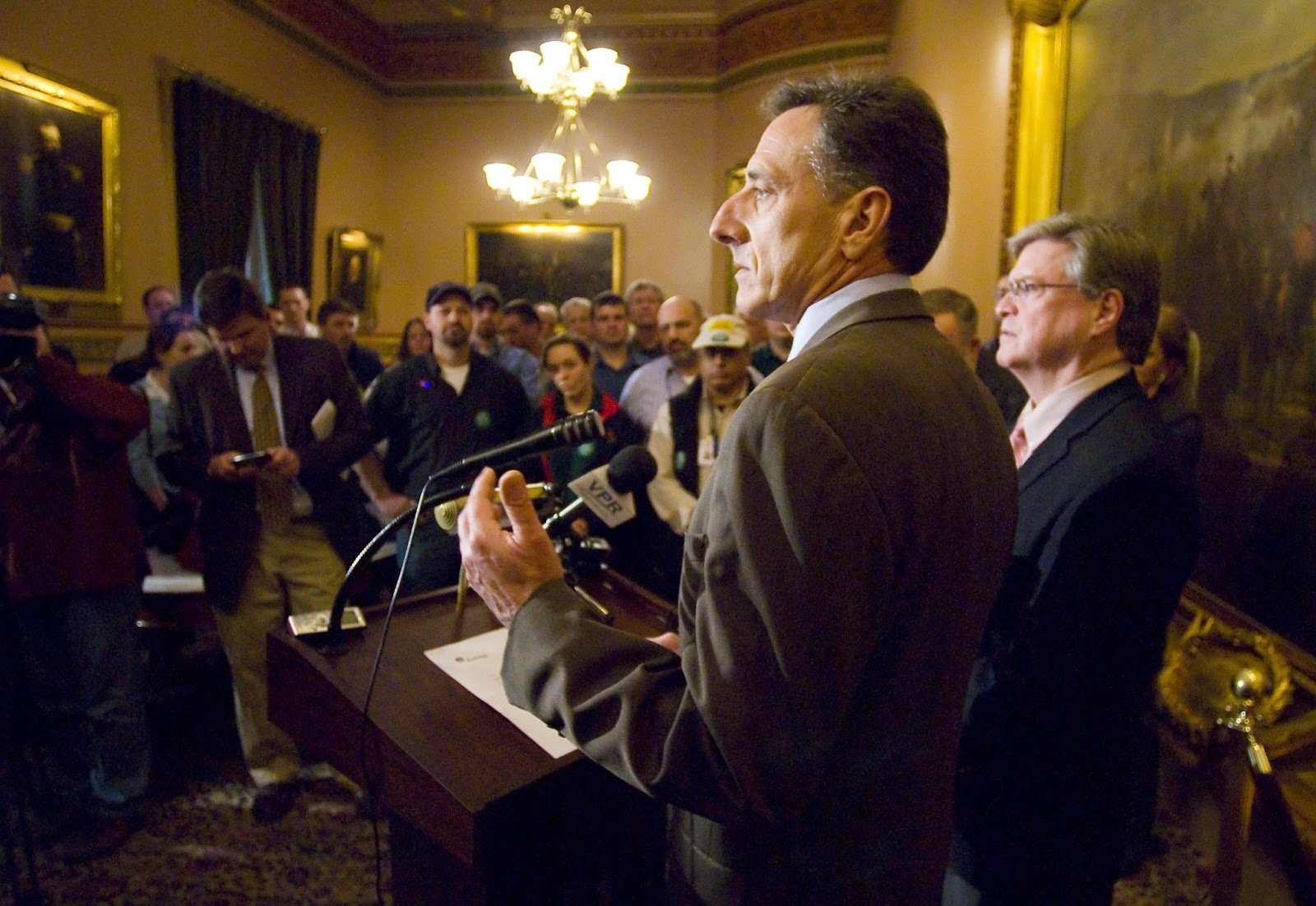
Vermont residents and activists join a Greenpeace rally outside the Statehouse, following a vote by Vermont Senate to retire the Vermont Yankee nuclear plant in 2012.
In February 2010 Greenpeace and our Vermont colleagues convinced the Vermontlegislature to reject the license from the state’s lone nuclear plant, Vermont Yankee and shut the plant down in 2012. The Vermont Senate voted 26 to 4 that operating Vermont Yankee was not in the best interest of Vermonters.
Entergy, the out-of-state corporate owners of Vermont Yankee, challenged this ruling in court. Last January U.S. District Court Judge Murtha sided with Entergy and said that Vermont wasimproperly motivated by safety.
The State of Vermont appealed that ruling and was in court in New York yesterday.
Below is an account of yesterday’s hearing from Richard Watts, University of Vermont professor and author of Public Meltdown: The Story of Vermont Yankee.
At a few minutes before 10:00, the court room on the 17th Floor of the Federal Court House in Manhattan fell silent. More than 80 dark-suited (mostly) lawyers and observers turned quiet as they waited to hear the arguments in the latest round of Entergy et al. v. Vermont et al this cool New York City morning January 14.
After the judges entered and the court was called to order, there was a moment, fittingly, when four Vermont journalists were allowed to take photos (see VT Digger and Vermont Public Radio). Then the action was fast and furious. Over the next 37 minutes, the two hired guns; Kathleen Sullivan for Entergy and David Frederick representing Vermont, argued clearly and passionately, responding to the frequent interruptions with aplomb, disagreeing politely with the judges and quoting legal rulings with ease. The bespectacled Frederick used his hands sparingly, Sullivans gestures were expansive despite the high stakes, both clearly comfortable in the dark-paneled court room.Bill Sorrell and David Fredericks answer questions from the press in front of the Thurgood Marshall Federal Court House, Foley Square, Manhattan.
How did it come to this, a court room on the 17th floor of a massive federal building hundreds of miles from Vermont? I joined a group of other Vermonters who traveled to watch the oral arguments before the 2nd Circuit Court of Appeals. I wanted to continue to explore the question of how a plant that provided more than one-third of the state s electricity for over 40 years went from valued asset to pariah at odds with state regulators, the states governor and state policy-makers. Many other Vermonters made the trip; Attorney-General Bill Sorrell and his legal team, CLFs Sandra Levine and advocates representing Entergy, Beyond Nuclear and the Citizen Awareness Network. The Vermont press turned out in numbers; Vermont Public Radio; WPTZ and WCAX and VT Digger among others.
First the court case: At stake is the future of Vermonts lone nuclear power plant, but also the role of states in regulating power plants within their borders. Can states seek preferential power rates in exchange for hosting power plants? Can states look at the power plants they host when it comes to the states vision for its future? And for Vermont, which lost round one in the case, an adverse ruling could mean the state would have to pay millions in legal fees (Entergys charge for round one in US District Court was $4.62 million). Vermont AG Bill Sorrell and Governor Peter Shumlins careers are tied to closing Vermont Yankee.
Who won? I dont know. But the Vermont legal team seemed buoyed by the course of the debate. For example, the judges seeming discounting of the dormant commerce clause would take the state off the hook for Entergys legal fees. On the record, AG Sorrell and Mr. Fredericks were pleased. Observers, such as Vermont Law Professor Cheryl Hannah and CLFs Sandra Levine also saw the state as doing well.
Sandra Levine of the Conservation Law Foundation.
The Entergy legal team (about ten I counted) left without commenting although I noted they did take the subway. A spokesperson for the company, Jim Steets stayed behind to tell the press that Kathleen Sullivan did a pretty good job in explaining why Judge Murtha was right (Round One). Steets also reiterated a Sullivan statement from the arguments that there was a Cherry Orchard of evidence that Vermont legislators were after safety a counter sound-bite to the cherry-picking argument of the state when it came to Judge Murthas review of the legislative record. That memorable VT legislators line lets find another word for safety also reappeared. (By the way Entergy and the states briefs can be found on the AGs web page here)
Entergy Legal team crossing Foley Square. Kathleen Sullivan is in the middle.
Following the end of the arguments I noticed that Sullivan approached Fredericks concerned that the judges had misunderstood that the plant was no longer providing electricity in Vermont. Sullivan suggested they correct the record. Fredericks was having no part of that. If the judges want more information they can ask he said. And they will. As we waited to retrieve our laptops and electronic devices, I said hello to Sullivan and the Entergy legal team. Entergys lead counsel, Marcus Brown had read my book on the back story (Public Meltdown) closely I was told.
As I watched the rapid fire of the skilled lawyers I wondered again how it came to this. When Entergy bought the plant in 2002 they committed to seeking state approval before operating past 2012. State officials welcomed the purchase. As late as 2009, state officials still strongly supported the plant, seeing potential economic benefits of above $5 billion from continued operation (Public Meltdown, pages 61-64). Vermont state utility officials told me if they had a PPA with Entergy a state permit would have been possible (pages 68-72).
But along the way, the company lost all that public and policy-maker good will. And now the company is fighting on numerous fronts in Vermont, at the state supreme court (this coming Wed) in the on-going PSB relicensing process where a decision could close the plant http://psb.vermont.gov/docketsand%20projects/electric/7862
In the end what may close the plant may be the financial costs of operating an aging nuclear power plant in an era when wholesale electricity prices have dropped as reported in the Brattleboro Reformer.
But was there something intrinsic to how Entergy operated in Vermont that led to this 17th floor court room? Or perhaps endemic to the nuclear power industry and how plants are owned and operated these days as Matt Wald has pointed out in the New York Times’ Green Blog.
Or was it that Entergys particular behavior in Vermont that destroyed the companys prospects as Entergy Executive Vice President Curtis Hebert wrote in a fact-finding memo to Entergy CEO Wayne Leonard in the spring of 2010. Actions that were described by one of the plants strongest supporters this way: the dissembling, the prevarication, the lack of candor have been striking, and theres not enough time to correct that (Public Meltdown, page 131).
It looks like that time has long since run out.
—-
Stay updated on Entergy vs. Vermont by liking Public Meltdown: The Story of Vermont Yankee Nuclear Power Plant by Richard A. Watts on Facebook and Twitter.



